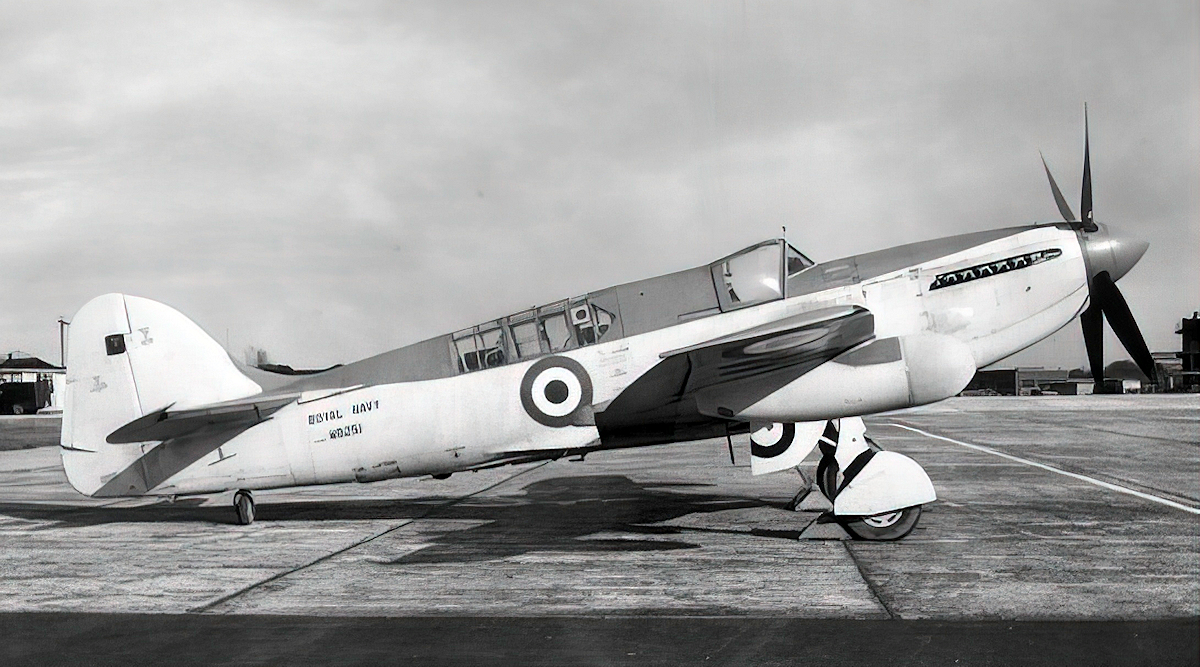



The squadron officially re-formed at RNAS Abbotsinch on August 15th 1947 as an RNVR squadron under the command of Lt. Cdr (A) J. D. Murricane DSC RNVR. It was one of four squadrons formed in 1947 for the RNVR Air Branch, the other three were Fighter squadrons; 1831 at RNAS Stretton, 1832 at RNAS Culham, and 1833 at RNAS Bramcote, 1830 was the only RNVR squadron to have joint Fighter/Anti-submarine tasking. Initial equipment issue was 3 Seafire F. XVIIs and 3 Firefly FR.1s. In May 1948 the fighter role was dropped and No.1830 standardised on Fireflies.
Flying took place at RNAS Abbotsinch each week-end. Pilots and Observers were required to carry out 14 days' continuous training each year, 100 hours non-continuous training (drills), and 12 week-ends on squadron duty. During this time they were expected achieve a minimum of 75 and a maximum of 125 flying hours. The two weeks of continuous annual training in air warfare and weapons training was carried out at other naval air stations; the first was at RNAS Eglinton, 16-30th October 1948.
On July 1st the squadron
relocated to
RNAS Donibristle to allow temporary repairs to be made to the
fast deteriorating runways at Abbotsinch, intensive ADDLS (Aerodrome Dummy
Deck Landings) had begun to expose holes in the Somerfield matting that
formed the runways.
RNS Donibristle was not an ideal
station for conducting ADDLS either, having only two runways orientated
roughly E-W and WSW-ENE landing into wind was not always possible.
When this occurred the squadron flew to RAF Leuchars to conduct ADDLS.
The second annual training period was spent afloat. This was an experiment with 1830 as the Guinea pigs; could part-time aviators carry out the rigours of flying from a carrier? The squadron flew out from RNAS Donibristle to joinethe training carrier ILLUSTRIOUS on August 27th 1949 for 10 days of r intensive flying training at sea. Completing on September 10th they had flown 196 flying hours and completed 205 accident-free deck landings. As a result of this feat theyt became the first, and only RNVR squadron to be awarded annual Boyd Trophy, awarded to a squadron or individual aircrew who had achieved the finest feat of aviation during the year. On disembarking they flew ashore to RNAS Abbotsinch.

A Fairey Firefly FR.5
The squadron flew to Malta for their next annual training period, arriving at RNAS Hal Far on July 30th 1950. The flight out to Malta was accomplished in one day, with a stop for lunch at Hyeres outside Toulon, as guests of the French Naval Air Service. The squadron ground personnel, additional pilots, stores. etc., were flown out by a civilian airline, with a stop at Nice. 1830 now began a considerable armament and A/S training programme, carrying out rocket attacks on targets off the coast, and exercising with units of the Mediterranean Fleet. The training complete on August 10th and the squadron returned to RNAS Abbotsinch.
In December 1950 the squadron once again moved temporarily to RNS Donibristle, this time to enable the Abbotsinch runways to be reconstructed; they did not return until November 1952.
On June 1st 1952 the squadrons of the RNVR Air Branch and its squadrons was reorganized into 5 Divisions; Scottish, Northern, Midland, Southern, and Channel. The Scottish Air Division was formed at RNAS Donibristle initially comprising of only 1830 squadron. However on October 1st 1830A squadron was formed as a second RNVR Anti-Submarine squadron, sharing the aircraft of 1830 Squadron; in March 1953 it become 1843 squadron.
1830 received new equipment in October 1950, Firefly AS.6s replacing the older FR.1 models.

A Grumman Avenger AS.5.
Due tor defence spending cuts the R.N.V.R. Air Branch was axed in 1957, the organisation and its squadrons ceased to exist on March 10th 1957.
Content revised: 19 September 2022
Additional sources:
Davies., G. (1997) 'Murricane's Men - the Scottish Air Division 1947 - 1957', Paisley, Giles Davies Ltd

Approved 1944
Motto: Force on
Sabang 1944
Palembang 1945
Okinawa 1945
Seafire F. XVII Aug 47 - May 48
Harvard T.2b Jan 50 - Oct 54
Harvard T.3 Jan 50 - Mar 55
Firefly FR.1 Aug 47 - Oct 51
Firefly T.1 Jun 48 - Nov 49
Firefly T.2 Oct 50 - Nov 55
Firefly T.3 Oct 50 - Oct 51
Firefly FR.5 Aug 53 - Nov 155
Firefly AS.6 Oct 51 - Nov 55
Sea Fury T.20 Oct 52 - Oct 54
Anson I Apr 1953 - Jul 1953
Sea Prince T.1 Jul 53 - May 56
Oxford Sep 53 - Jan 55
Sea Balliol T.21 Oct 54 - Mar 57
Avenger AS.5 Nov 55 - Mar 57
Lt. Cdr (A) J. D. Murricane DSC RNVR 15 Aug 47
Lt. Cdr (A) R. C. Read RNVR 1 Jun 52
Squadron disbanded 10 Mar 197
Aircrew and squadron personnel
None
© 1999-2026 The Royal Navy Research Archive All Rights Reserved Powered by W3,CSS
Press F5 to refresh the page after posting your comment or to hide the form
Note
Records indicate that the Sea Otters issued at RNAS Lee-on—Solent were passed to 1701 Sqn which formed there on February 1st 1945. It is assumed that only squadron personnel embarked in KHEDIVE for passage, aircraft, equipment and stores being issued on arrival in India.
Comments (0)